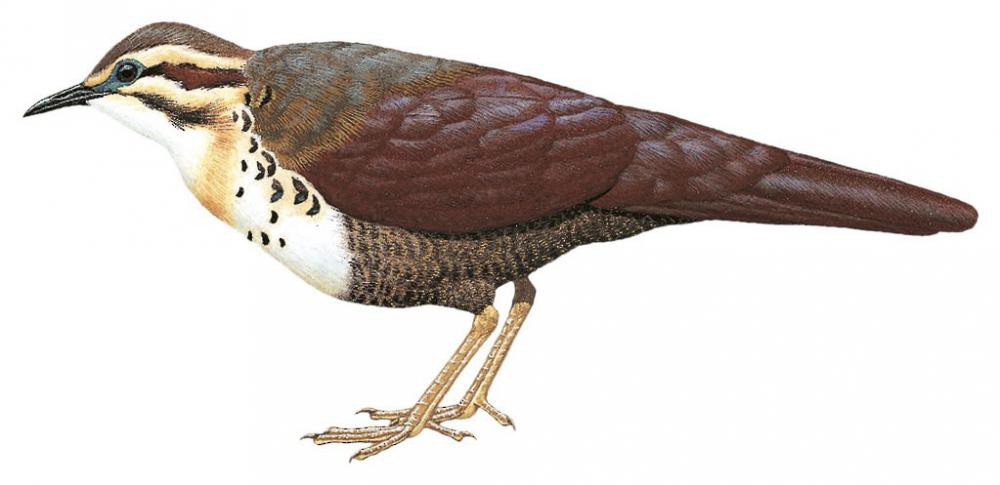White-breasted Mesite / Mesitornis variegatus

White-breasted Mesite
SCI Name:
Protonym: Mesites variegata Compt.Rend. 6 p.444
Taxonomy: Mesitornithiformes / Mesitornithidae / Mesitornis
Taxonomy Code: whbmes2
Type Locality: Madagascar.
Author: Geoffroy Saint-Hilaire, I
Publish Year: 1838
IUCN Status: Vulnerable
DEFINITIONS
MESITORNIS
(Mesitornithidae; Ϯ White-breasted Mesite M. variegatus) Genus Mesites I. Geoffroy Saint-Hilaire, 1839, mesite; Gr. ορνις ornis, ορνιθος ornithos bird; "Pour le genre 1739 Mesites, Is. Geoffr., genre d'Oiseaux des plus singuliers du globe, il se trompe en lui attribuant la date de 1839, tandis qu'il est décrit tout au long dans le tome VI des Comptes rendus de l'Académie avec la Philepitta et l'Oriolie moins importants que lui, et dont la date est donnée correctement 1838 et même du commencement (9 avril). Il ne sera donc pas nécessaire de changer ce nom (et avec lui celui de la famille) pas même en Mesitornis! il n'y aura à le céder ni au Coléoptère de la fin de la même année, ni au Poisson de 1842, ni à la plante papilionacée Mesitis et non Mesites" (Bonaparte 1855); "MESITORNIS Bonaparte, 1855 M — Mesites variegata I. Geoffroy Saint-Hilaire, 1838; type by original designation 7 ... 7 Peters (1934) used Mesoenas Reichenbach, 1861, as the generic name in place of Mesites I. Geoffroy Saint-Hilaire, 1838, preoccupied by Mesites C. J. Schönherr, 1838 [Coleoptera]. Mesitornis Bonaparte, 1855, although universally adopted instead, was not properly introduced. It is maintained here for the sake of stability but will have to be the subject of an application to the I.C.Z.N." (Dickinson & Remsen (eds.) 2013, 82). The Mesitornithidae is a family of uncertain relatonships, formerly considered to be primitive Ralliformes, but now thought to be more closely related to the Columbiformes (see Monias).
Synon. Mesites, Mesoenas.
variegatum / variegatus
L. variegatus variegated < variare to variegate < varius various, diverse.
● ex “Actenoïde variée” of Hombron & Jacquinot 1846 (syn. Actenoides hombroni).
● ex “Variegated Sandpiper” of Latham 1785 (syn. Aphriza virgata).
● ex “Grive 2da” of Fermin 1769, and “Variegated Thrush” of Latham 1783 (syn. Campylorhynchus turdinus).
● ex “Tinamou varié de Cayenne” of d’Aubenton 1765-1781, pl. 828, “Tinamou varié” of de Buffon 1770-1783, and Bajon 1777, and “Variegated Tinamou” of Latham 1783 (Crypturellus).
● ex “Coucou tacheté de l’île de Panay” of Sonnerat 1776 (syn. Eudynamys scolopaceus mindanensis).
● ex “Grand Indicateur, femelle” of Levaillant 1806 (Indicator).
● ex “Garza varia” of de Azara 1802-1805, no. 361 (syn. Ixobrychus involucris).
● ex “Mésange Grisette” of Levaillant 1803, pl. 138 (syn. Melaniparus cinerascens).
● ex “Guêpier à collier gros-bleu” or “Guêpier Sonnini” of Levaillant 1807 (Merops).
● ex “Courly tacheté de l’isle de Luçon” of Sonnerat 1776 (subsp. Numenius phaeopus).
● ex “Râle tacheté de Cayenne” of d’Aubenton 1765-1781, pl. 775, and “Variegated Rail” of Latham 1785 (syn. Pardirallus maculatus).
● ex “Averano” of de Buffon 1770-1783 (syn. Procnias averano).
● “It has been pointed out to me by Mr. T. Iredale that the name Tetrao variegatus Burchell ...[1824] is preoccupied by Tetrao variegatus Gmelin ...[1789], bestowed on the Variegated Tinamou of Latham, and now known as Crypturus variegatus. As there appears to be no synonym for this distinct species of Sandgrouse, I propose to rename it after the discoverer” (W. Sclater 1922) (syn. Pterocles burchelli).
UPPERCASE: current genus
Uppercase first letter: generic synonym
● and ● See: generic homonyms
lowercase: species and subspecies
●: early names, variants, mispellings
‡: extinct
†: type species
Gr.: ancient Greek
L.: Latin
<: derived from
syn: synonym of
/: separates historical and modern geographic names
ex: based on
TL: type locality
OD: original diagnosis (genus) or original description (species)












